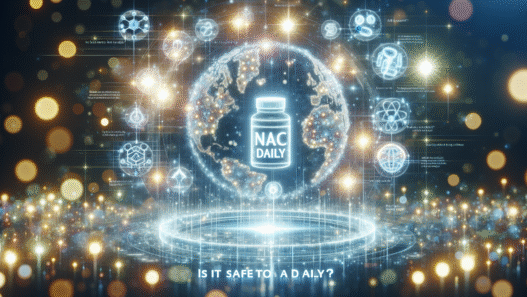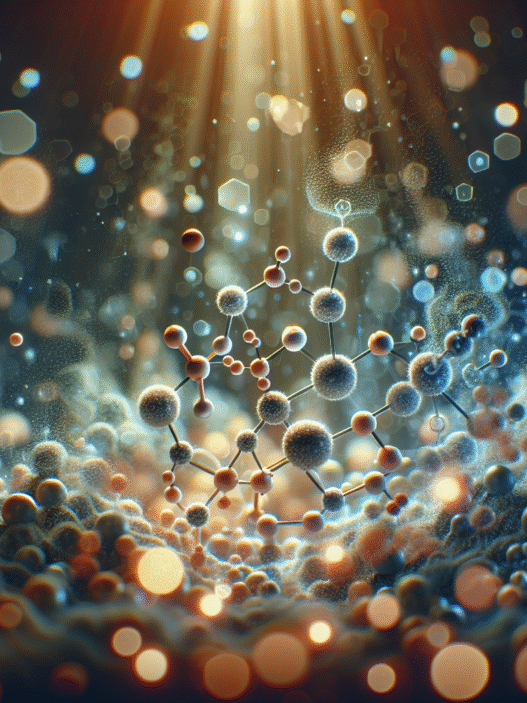Understanding N-Acetyl Cysteine (NAC)
NAC Basics
N-Acetyl Cysteine (NAC) is a derivative of the amino acid cysteine and is recognized for its significant health benefits, particularly in the fields of detoxification and longevity. As an antioxidant, it plays a crucial role in replenishing levels of glutathione, a powerful antioxidant that safeguards cells from oxidative damage. NAC is widely regarded for its safety profile and is approved by both the FDA and WHO, primarily for treating acetaminophen overdose and functioning as a mucolytic agent in respiratory diseases.
Table 1 below provides a summary of NAC’s fundamental properties.
| Property | Description |
|---|---|
| Chemical Structure | Derivative of cysteine |
| Major Function | Antioxidant and anti-inflammatory |
| FDA Approval | Yes (for acetaminophen overdose treatment) |
| Common Use | Mucolytic agent in respiratory conditions |
Mechanisms of Action
NAC’s effectiveness is largely attributed to its ability to increase intracellular glutathione levels, which are essential for maintaining cellular redox balance. Additionally, NAC reduces levels of pro-inflammatory cytokines by inhibiting the activity of nuclear factor kappa B (NF-κB), thereby showcasing its anti-inflammatory properties. This dual action—antioxidant and anti-inflammatory—illustrates NAC’s potential benefits in addressing various health concerns associated with oxidative stress and inflammation (PubMed Central).
The table below outlines the primary mechanisms through which NAC operates in the body.
| Mechanism | Description |
|---|---|
| Glutathione Production | Increases levels of glutathione, enhancing antioxidant defenses |
| Inhibition of NF-κB | Reduces pro-inflammatory cytokines, lowering inflammation |
| Cellular Protection | Protects against oxidative damage in cells |
NAC has garnered attention not only for its therapeutic applications in medical settings but also for its emerging role in skin health and longevity. The antioxidant properties of NAC make it particularly relevant in the context of n-acetyl cysteine skin anti-aging, making it an essential consideration for those seeking to enhance their skin’s longevity. For more information on its skin benefits, be sure to explore our articles on n-acetyl cysteine for skin and nac for anti-aging.
NAC and Medical Uses
N-Acetyl Cysteine (NAC) is not only valued for its anti-aging properties but also for its extensive medical applications. This section explores its role in treating various dermatological conditions, as well as its benefits for renal and cardiovascular health.
Dermatological Conditions
NAC has shown promise in treating a range of dermatological conditions. Research indicates its efficacy in disorders such as:
- Excoriation disorder
- Onychophagia disorder
- Trichotillomania
- Acne vulgaris
- Type I lamellar ichthyosis
- Bullous morphea
- Systemic sclerosis
- Toxic epidermal necrolysis
- Atopic dermatitis
- Xeroderma pigmentosum
- Pseudoporphyria
These conditions reflect NAC’s versatility in dermatology and its potential benefits for skin health in various contexts. For more on how NAC impacts skin, see our article on N-acetyl cysteine for skin.
| Dermatological Condition | NAC Efficacy |
|---|---|
| Excoriation disorder | Effective |
| Acne vulgaris | Effective |
| Atopic dermatitis | Effective |
| Toxic epidermal necrolysis | Effective |
Renal and Cardiovascular Benefits
NAC also demonstrates significant benefits for renal and cardiovascular health. Studies indicate that he may help prevent acute kidney injury, particularly after cardiac surgery. A randomized controlled trial highlights its effectiveness in this area.
Furthermore, NAC might aid in managing blood pressure levels, though caution is advised when combining it with blood pressure-lowering medications, as it may compound effects (WebMD).
| Health Aspect | NAC Influence |
|---|---|
| Acute Kidney Injury Prevention | Effective |
| Blood Pressure Reduction | Possible |
Incorporating NAC can potentially improve both skin conditions and overall health, making it an important discussion point for those interested in skin rejuvenation and longevity. For broader insight into NAC’s health benefits, refer to our article on n-acetyl cysteine benefits.
NAC for Skin Health
N-Acetyl Cysteine (NAC) offers several benefits for skin health, including its anti-aging effects and its role in photoprotection. These properties make it a valuable compound for anyone seeking to enhance their skin’s longevity.
Anti-Aging Effects
One of the primary benefits of NAC is its antioxidant activity, which is crucial for fighting signs of aging. NAC helps to restore the skin’s natural antioxidant defenses, ultimately reducing oxidative stress. This stress is a key contributor to skin aging, as it can damage collagen and lead to wrinkles. Studies have shown that NAC influences the signaling pathways involved in skin aging, promoting healthier cellular functions and reducing the overall aging process NAC for Anti-Aging.
In clinical trials, topical applications of NAC have been found to yield significant benefits. For instance, a 5% NAC gel applied to individuals with acne vulgaris resulted in better outcomes in reducing comedone counts than a placebo group PubMed Central. This suggests that NAC not only fights aging but also addresses skin imperfections associated with age.
| Anti-Aging Benefits of NAC | Effectiveness |
|---|---|
| Reduces oxidative stress | High |
| Enhances collagen production | High |
| Improves skin texture | Moderate |
| Reduces wrinkles | Moderate |
Photoprotective Role
NAC plays a significant role in protecting the skin from photodamage caused by ultraviolet (UV) radiation. The antioxidant properties of NAC help interrupt the UV signaling cascade, leading to photoaging. By increasing the antioxidant capacity of human skin, NAC provides protection to melanocytes, the cells that produce melanin, from UV-induced oxidative stress and damage NCBI.
Utilizing NAC effectively in formulation can enhance skin care products designed to combat sun damage, making it an excellent addition for those concerned about skin health. Its protective role makes it relevant for individuals looking to maintain youthful skin while minimizing the effects of sun exposure.
In summary, incorporating NAC in skincare routines can enhance skin longevity and promote healthier, more resilient skin. The combination of anti-aging effects and photoprotection positions NAC as a promising ingredient for maintaining youthful and vibrant skin. For further insights on how to integrate NAC into skin health regimens, refer to n-acetyl cysteine for skin.
NAC in Clinical Trials
N-Acetyl Cysteine (NAC) has gained attention not only for its skin benefits but also for its potential in clinical applications. This section focuses on its role in wound healing and its impact on psychiatric disorders.
Wound Healing Studies
NAC has shown promising results in enhancing wound healing through various mechanisms. Research indicates that NAC increases angiogenesis, promotes fibroblast proliferation, and reduces oxidative stress, all of which contribute to improved wound healing rates (NCBI).
| Clinical Study | Key Findings |
|---|---|
| Study A | Increased angiogenesis was observed when NAC was applied topically to wounds. |
| Study B | NAC improved fibroblast activity, leading to better tissue regeneration. |
| Study C | Reduction in oxidative stress levels was noted, correlating with faster healing. |
NAC’s ability to enhance recovery rates positions it as an important candidate for further exploration in clinical settings related to wound care.
Psychiatric Disorders
The efficacy of NAC in treating psychiatric disorders has been evaluated in several clinical trials. Research suggests that NAC may help in reducing symptoms associated with certain mental health conditions. Its mechanism includes modulation of glutamate levels and its antioxidant properties, which may provide neuroprotective effects.
| Clinical Study | Conditions Treated | Key Findings |
|---|---|---|
| Study X | Bipolar Disorder | NAC showed a reduction in manic symptoms. |
| Study Y | Depression | Patients experienced improved mood and emotional response. |
| Study Z | OCD | Symptoms decreased notably with regular NAC administration. |
While these studies indicate positive outcomes, further research is necessary to validate NAC’s effectiveness as a treatment option for psychiatric disorders.
NAC is continually being studied for its diverse applications, including its potential for skin rejuvenation and anti-aging properties, making it a compound of interest among those focused on longevity and overall skin health. Its unique combination of antioxidant and anti-inflammatory properties could revolutionize not only dermatological care but also approaches to mental health and recovery. For more information on how NAC can benefit skin health, see our article on n-acetyl cysteine for skin.
Safety and Administration of NAC
N-Acetyl Cysteine (NAC) is gaining attention for its numerous health benefits, including its role in skin health and anti-aging. It’s essential to consider the appropriate dosage and potential side effects when incorporating this supplement into one’s routine.
Dosage and Administration
NAC can be administered through various routes, including orally, intravenously, or by inhalation. The oral route is the most common and demonstrates rapid absorption and metabolic processes by the liver. However, the bioavailability of free NAC is low, typically less than 10%, meaning only a small fraction of the intact molecule reaches plasma and tissues.
| Administration Route | Bioavailability | Common Dosage Range |
|---|---|---|
| Oral | <10% | 600 mg to 1200 mg per day |
| Intravenous | High | Determined by medical professional |
| Inhalation | Moderate | Variable based on indication |
For individuals seeking N-acetyl cysteine skin anti-aging, typical oral dosages range from 600 mg to 1200 mg per day, depending on the specific health goals and recommendations from a healthcare provider.
Potential Side Effects
NAC is generally considered safe and tolerable, with a well-established safety profile. However, some individuals may experience side effects, including:
- Gastrointestinal upset
- Nausea
- Diarrhea
- Allergic reactions (rare)
Serious side effects are uncommon but may occur, particularly with rapid intravenous administration or in individuals with specific predispositions. Health practitioners often recommend monitoring when starting NAC, especially for those using it for long-term benefits like longevity and skin health.
Individuals looking to explore the comprehensive benefits of NAC can refer to additional resources, including n-acetyl cysteine benefits and nac supplement benefits. Understanding the dosage and potential side effects is crucial for safely reaping the rewards of this promising supplement.
Future Research on NAC
Ongoing Studies
Research regarding N-acetyl cysteine (NAC) continues to expand, focusing on its multifaceted applications. Current studies are investigating NAC’s effectiveness in various conditions, including respiratory diseases like chronic obstructive pulmonary disease (COPD) and cystic fibrosis. Additionally, trials are exploring NAC’s role in psychiatric conditions such as schizophrenia, with preliminary findings suggesting that NAC supplementation can improve cognitive performance and reduce symptoms associated with these disorders (PubMed Central).
NAC’s dermatological potential is also being evaluated, particularly its efficacy in treating conditions such as acne vulgaris and systemic sclerosis. Clinical trials aim to further assess how NAC could enhance overall skin health and longevity in different populations.
| Condition | Study Focus | Potential Benefits |
|---|---|---|
| COPD | Efficacy of NAC | Reduction of symptoms and improvement of lung function |
| Schizophrenia | Cognitive performance | Improvement of cognitive symptoms at doses ranging from 1200-2000 mg |
| Acne Vulgaris | Skin health | Reduction in acne severity and improvement of skin appearance |
Emerging Applications
Beyond its established uses, NAC is gaining attention for emerging applications in skin health and anti-aging treatments. Understanding how NAC acts as an antioxidant—by replenishing glutathione levels and scavenging reactive oxygen species—highlights its potential for skin rejuvenation. Ongoing research aims to explore NAC’s role in various dermatological applications, including:
- Anti-Aging: Studies are examining how NAC can improve skin elasticity and reduce wrinkles, making it a candidate for incorporation into anti-aging products (nac for anti-aging).
- Skin Rejuvenation: Its potential use in skin care formulations could help rejuvenate aging skin and promote a healthier complexion.
- Supplementation: Research on combining NAC with other ingredients in health supplements for enhanced benefits suggests its role in broader anti-aging protocols (nac supplement for anti-aging).
The promising nature of these studies indicates a bright future for NAC in the realm of skincare and overall wellness, especially for those seeking effective solutions for skin longevity. As more data emerges, the beauty and healthcare industries are likely to see more products featuring NAC, enhancing its profile as a powerful agent against aging and skin deterioration. For detailed information on its skin benefits, refer to our article on n-acetyl cysteine skin benefits.





















